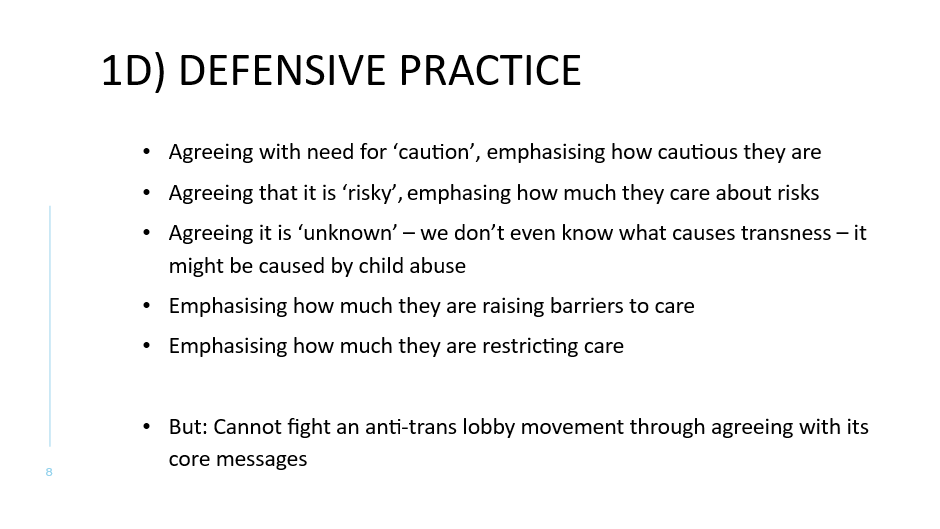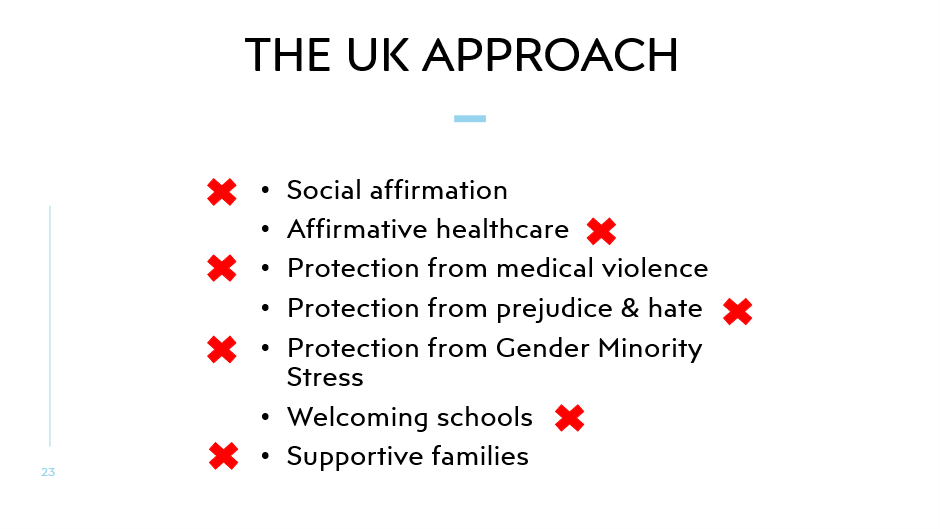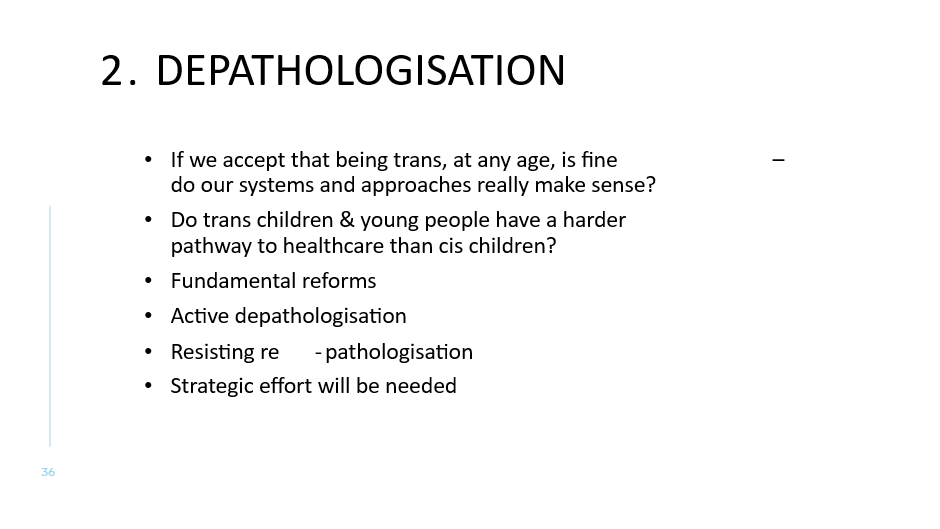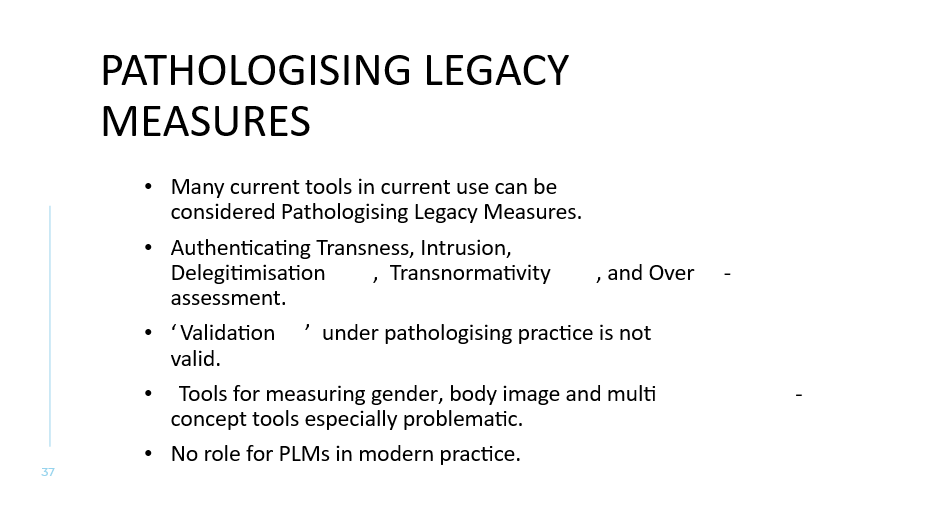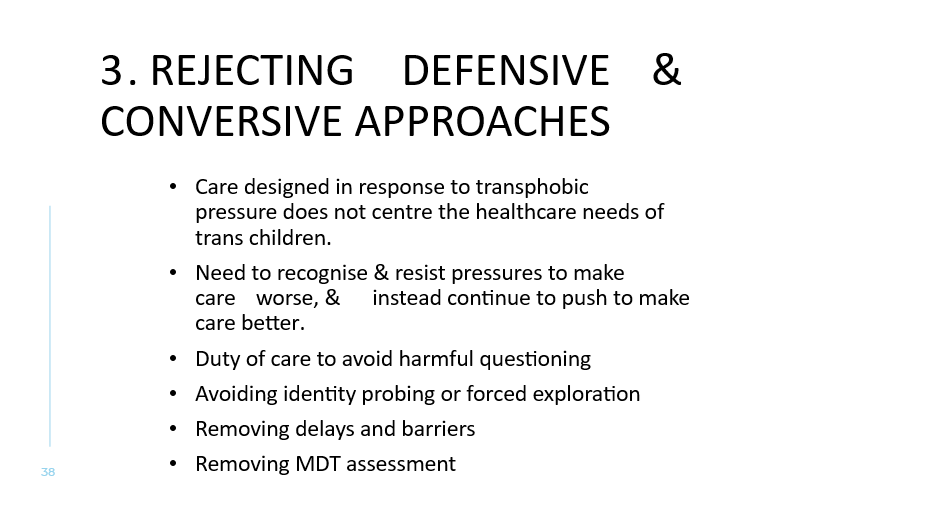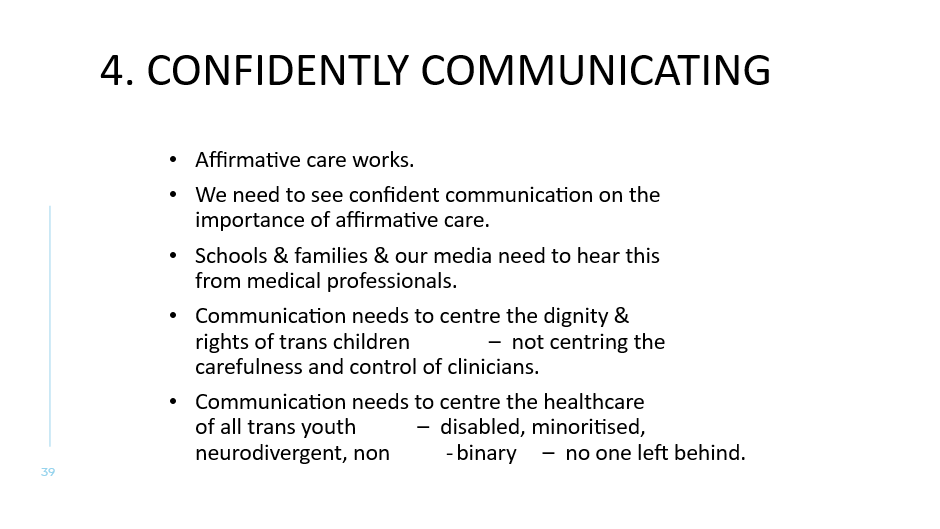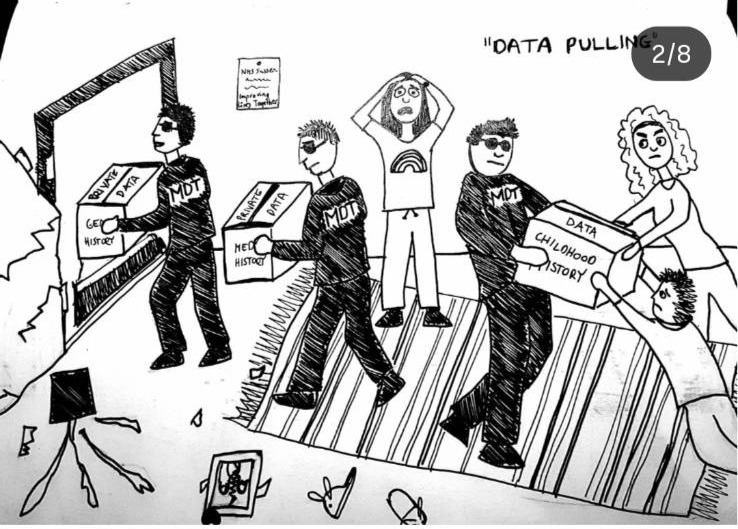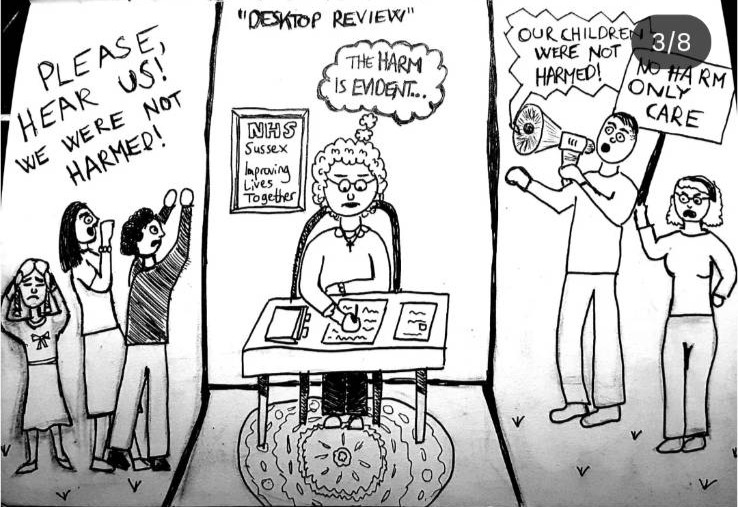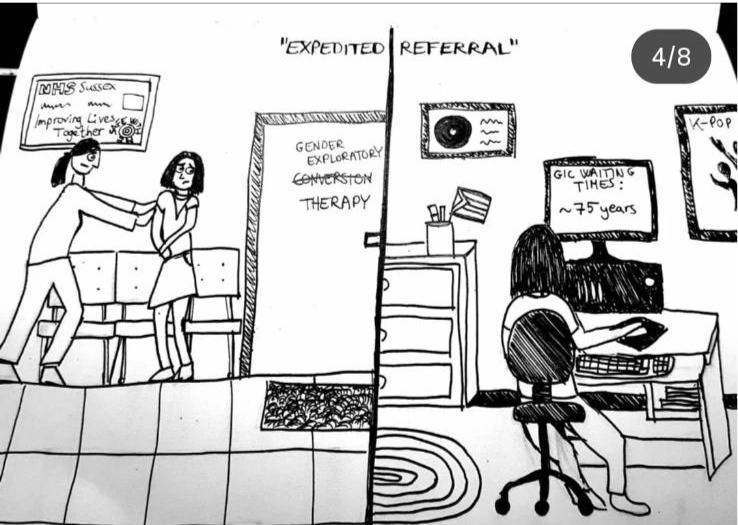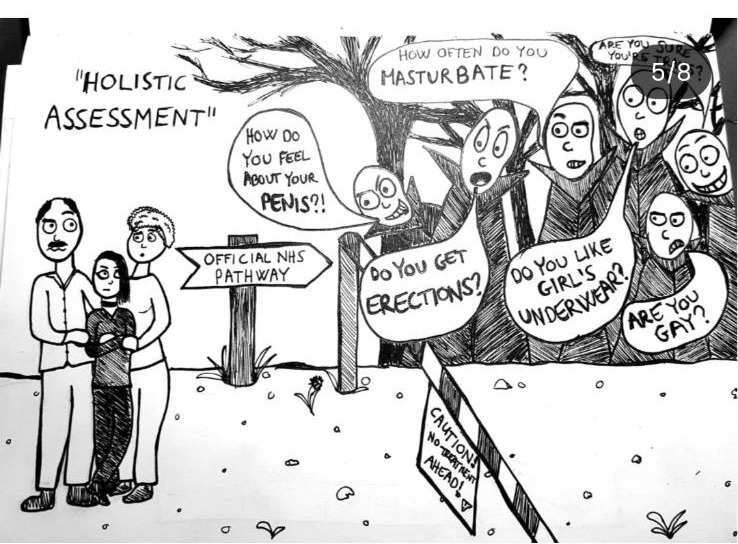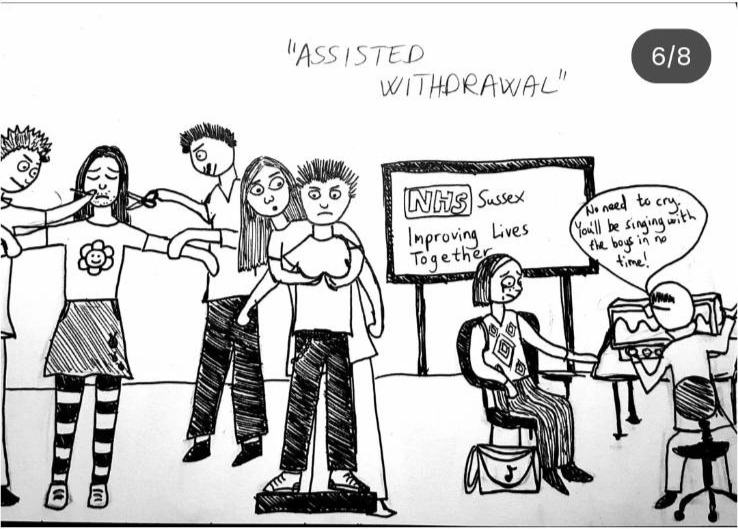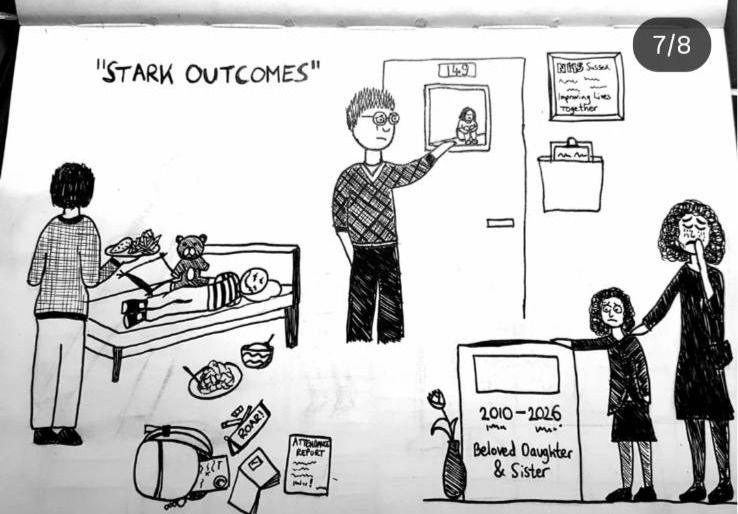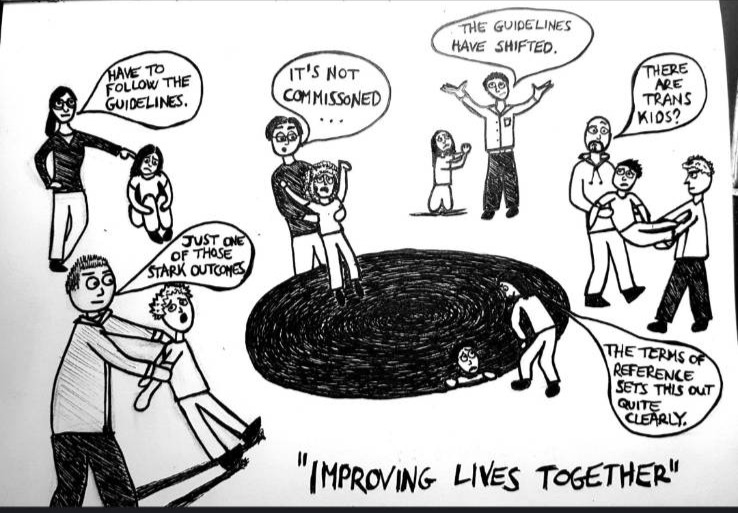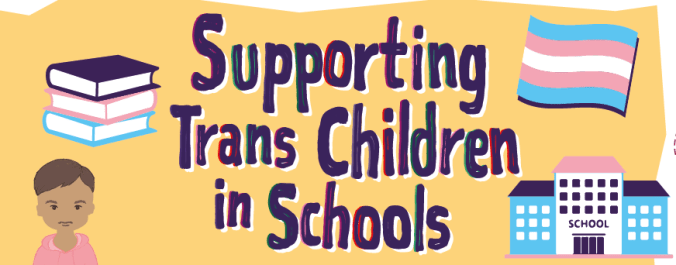
The UK media is full of scaremongering about puberty blockers (GnRHa) and the evidence or supposed lack thereof in support of their use for trans adolescents. Opinions abound, but few, however, have the opportunity or access to read the academic literature. In this article, a comprehensive overview of the studies and academic literature on puberty blockers are presented, providing improved access to this evidence. Links to the papers are provided throughout, supported by a full bibliography.
Puberty blockers are a recommended intervention for trans youth at the start of puberty (when such interventions are requested), endorsed by the global Endocrine Society and WPATH (the World Professional Association for Transgender Health). Within medical and clinical service provider communities, strong consensus in support of puberty blockers has grown, with endorsement from the world’s largest paediatric health body the American Academy of Pediatrics, providing access to blockers throughout the USA, and national health services around the world including centres in Spain, Australia & New Zealand. Authors from the conservative UK NHS children’s gender service (GIDS), wrote a position paper in 2016 (Costa) stating that “Despite a limited number of studies, the existing literature supports puberty suppression as an early, sufficiently safe, and preventive treatment for gender dysphoria in childhood and adolescence”, with a more recent 2019 UK paediatric endocrinologist authored piece (Joseph) affirming that puberty suppression “is now a recommended treatment option”.
Puberty blockers have been used since the 1970s for children with precocious puberty, with extensive studies for this cohort (Eun Young Kim provides an overview of the literature), on their long-term use “considering evidence of impact on height, reproductive function, obesity and metabolic syndrome, bone mineral density and bone markers, polycystic ovary syndrome, psychosocial problems”. “Long–term studies on the recovery of reproductive function in precocious puberty patients of more than 6–20 years are being reported”. “Puberty was recovered within 1 year after GnRHa treatment discontinuation, and there were no abnormalities in reproductive function”. “Bone mineral density decreases during GnRHa treatment but recovers to normal afterwards, and peak bone mass formation through bone mineral accretion during puberty is not affected”. “Some studies have reported decreases in psychosocial problems after GnRHa treatment. Overall, GnRHa seems effective and safe for CPP patients, based on long-term follow-up studies.”
In trans youth, blockers have been studied since the late 1980s. An early paper published in 1998 (Cohen Kettenis) reported on the protocols followed for a 13 year old trans boy who was treated with puberty blockers, with HRT (Hormone Replacement Therapy) and surgery after turning 18. This was the first longitudinal case study, which documented a successful outcome from using early puberty blockers. As an adult, the subject was happy and satisfied with the outcomes, (though noted the delays between blockers and HRT were overly long).
The longest follow-up study is of a Dutch trans man who started on puberty blockers at age 13 in 1988. His health and well being was monitored\ regularly for over 22 years, when he was last followed up, aged 35 (in 2010) he was well-functioning with no clinical signs of a negative impact of earlier puberty suppression on brain development, metabolic and endocrine parameters, or bone mineral density (Cohen Kettenis, 2011).
Their use in trans adolescents has been well studied in the Netherlands. In 2011 (Kreukels) the then world leaders in what became known as “the Dutch Approach” wrote that they “believe that offering this medical intervention minimizes the harm to the youth while maximizing the opportunity for a good quality of life including social and sexual relationships, and that it respects the wishes of the person involved”. “Because the effects are reversible, this treatment phase could be considered an extended diagnostic phase. Knowing that the treatment will put a halt to the physical puberty development often results in a vast reduction of the distress that the physical feminization or masculinization was producing.”
Another 2011 study (De Vries) collected data from 2000-2008 of 70 trans youth (33 trans feminine, 37 trans masculine) capturing the time period when they were only receiving puberty blockers. Puberty blockers were started at an average age of 14.75 (youngest was 11.3). Youth received puberty blockers alone before starting HRT alongside for an average of 1.88 years (the shortest period on just puberty blockers was 0.42 years, the longest was 5.06 years). Whilst on puberty blockers there were improvements in behavioural and emotional problems, and reduced symptoms of depression, enabling healthy psychological development. There were not improvements in body image and gender dysphoria. “As expected, puberty suppression did not result in an amelioration of gender dysphoria. Previous studies have shown that only gender reassignment consisting of CSH (cross sex hormone) treatment and surgery may end the actual gender dysphoria”. All youths later went onto HRT (which did lead to improvements in body image and gender dysphoria as well as wider improvements to wellbeing (see 2014 study for follow up). In a clinic with a clear route to HRT (all youth in the study were later prescribed HRT) the authors speculate that improvements in wellbeing whilst on puberty blockers may be due to the youths on puberty blockers having confidence that a route to HRT is available.
A summary position statement from Amsterdam in 2011 (Kreukals) outlined their view: “In our opinion, to deny these youngsters GnRHa treatment is unreasonable. Although the physical effects of puberty suppression are reversible, it has been argued that the effects on psychosexual develop ment are not reversible: the adolescents will miss puberty that is a result of their own natal sex hormones. However, in this sense, denying GnRHa treatment is equally irreversible: the adolescents will never know how puberty in accordance with their gender identity will be, because that is made impossible by the effects of their own sex hormones. Transsexual adolescents often consider not experiencing the puberty of their desired sex more harmful than missing their natal puberty. As puberty suppression therapy generally results in a physical appearance that makes it possible to live unobtrusively in the desired gender role, withholding GnRHa treatment is also harmful because of the potential life-long social consequence s (such as stigmatization).”
Hembree (2011) reviewed other studies noting increased suicidal ideation where blockers were not given.
A 2012 paper (Edwards Leeper) from a major paediatric treatment centre in the USA, emphasised a key reason for puberty blockers – “44% of transgender youth presenting for medical intervention had been previously diagnosed with a psychiatric disorder, the most common being depression, anxiety, and bipolar disorder. Thirty-six percent of these patients had been prescribed psychotropic medications and 9% had been hospitalized psychiatrically in the past. These psychological problems often intensify when transgender children reach puberty”. They also note that “it is not uncommon for these symptoms to decrease and even disappear once the adolescent begins a social and physical transition. The previous diagnoses of major psychiatric disorders, especially mood disorders (e.g., major depressive disorder, bipolar disorder) in these patients are often secondary to their gender identity issue and many patients are “cured” of these disorders through medical intervention for the gender issue.” The authors emphasise multiple psychological benefits of pubertal suppression, especially through avoiding needless emotional and psychological suffering, which can be severe for some adolescents (e.g., self-harming behaviors and suicidality). Delamarre , in an earlier 2006 paper, highlights that once trans adolescents are on puberty blockers, their anxiety at physical changes is taken away, enabling them to concentrate on other issues, enabling them to better develop and socially connect with peers.
A 2014 study (De Vries) of 55 trans youth (22 trans feminine and 33 trans masculine) followed them over an 8 year period from before starting blockers (mean aged 13.6 years), through to start of blockers (average age 14.8, youngest 11.5) through to HRT (mean age 16.7, youngest 13.9) and at least one year after gender reassignment surgery for those who wanted surgery (mean age 20.7). This monitored not only psychological functioning (gender dysphoria, body image, global functioning, depression, anxiety, emotional and behavioural problems) but also tracked wellbeing (social and educational/professional functioning; quality of life, satisfaction with life and happiness). Psychological functioning steadily improved. Well-being improved to similar or better than same age young adults from the general population. “GD (gender dysphoria) and body image difficulties persisted through puberty suppression and remitted after the administration of CSH and GRS (at T2) (significant linear effects in 3 of 4 indicators, and significant quadratic effects in all indicators)“ “None of the participants reported regret during puberty suppression, CSH, treatment, or after GRS. Satisfaction with appearance in the new gender was high, and at T2 no one reported being treated by others as someone of their assigned gender”. “All young adults in this study were generally satisfied with their physical appearance and none regretted treatment. Puberty suppression had caused their bodies to not (further) develop contrary to their experienced gender”. “Psychological functioning improved steadily over time, resulting in rates of clinical problems that are indistinguishable from general population samples (eg, percent in the clinical range dropped from 30% to 7% on the YSR/ASR30) and quality of life, satisfaction with life, and subjective happiness comparable to same-age peers. They note that this support gave “these formerly gender dysphoric youth the opportunity to develop into well-functioning young adults. These individuals, of whom an even higher percentage than the general population were pursuing higher education, seem different from the transgender youth in community samples with high rates of mental health disorders, suicidality and self-harming behaviour”.
Paediatric endocrinologist Rosenthal outlined key endocrine considerations in 2014, highlighting the potential negative impact on bone health of extended pubertal suppression and arguing for earlier introduction of HRT, stating that delaying HRT until age 16 can be “detrimental to bone health”. In addition he stated the negative impacts on emotional well-being of denying trans youth the opportunity to progress through puberty at the same time as their peers, and thereby isolating them. For this reason, gender centres are “studying the impact of cross-sex hormone treatment initiation at 14 years of age (which approximates the upper end of the age range for normal pubertal onset in natal males and 1 year beyond the upper end of the age range in natal females”).
A 2014 paper (Khatchadourian) summarising treatment in a Canadian clinic emphasises the high rates of suicidal ideation before treatment, in a cohort not treated until an average age 16. “Importantly, 10 of the 84 patients (12%) had attempted suicide with a resultant visit to an emergency department before being seen in our clinic”. “The older age of our cohort of patients compared with the Dutch cohort (mean age 16.6 vs 14.6 years, respectively) may also explain differences in frequency of psychiatric comorbidity, as our patients had more time to develop these comorbidities.” They note a decrease in suicide attempts or visits to emergency departments for suicidal ideation once engaged with the clinic (from 10 incidents before treatments, to 4 after). “Although our numbers are quite small, this finding suggests a lessening of emotional problems and suicidality when puberty blockers or cross-sex hormones are started. This is further corroborated by findings in the Dutch cohort, where an improvement in psychological functioning in areas such as depressive symptoms was demonstrated in adolescents with gender dysphoria treated with GnRHa for nearly 2 years.” This study also emphasises youth who do not need to undergo interventions like painful electrolysis or chest surgery, as early treatment prevented unwanted pubertal development. The authors conclude that “most experts in transgender care would agree that initiation of GnRHa therapy at an earlier stage ofpuberty is preferred, because preventing the development of unwanted secondary sexual characteristics can alleviate distress.”.
A 2014 paper (Fisher) outlines the negative consequences in Italy where puberty blockers were not offered – 23 youth, (14 trans feminine, 9 trans masculine, average age 16.3 years old), who had been diagnosed with gender dysphoria but who had not been granted any medical intervention, had low levels of wellbeing, and high levels of emotional and behavioural problems. They also noted that a high proportion, 42%, had dropped out of school early. The authors from Italian clinical services consider ethical implications of prescribing or denying blockers. They discuss fertility, referring to wider studies and concluding “several studies report that fertility potential is not impaired by long-term treatment with GnRHa even when used in younger subjects, before age 7, to treat precocious puberty. In addition, GnRHa treatment seems to have a protective effect on the reproductive outcomes, as fertility problems were more prevalent in subjects with precocious puberty that were not treated when compared with those treated. Professionals should inform patients that sperm production can be satisfactory after cessation of GnRHa or with gonadotropin treatment (both associated with body virilisation. FtM individuals have to be informed that no adverse effects are expected in relation to their fertility when treated with GnRHa” They argue that the current (2014) clinical evidence as well as international clinical guidelines suggests that prompt prescription of puberty blockers provides the best outcome for trans adolescents. They note experience from Italy that later pubertal changes can be unbearable, changes that “are usually profoundly humiliating for transgender youth”. They add that unwanted pubertal changes “often perceived as devastating, may seriously interfere with healthy psychological functioning and well-being”, being associated with worsening gender dysphoria, distress, depression, self-harming behaviour, anxiety, low self-esteem, social isolation and suicidal ideation. They emphasise that “although there are cases of comorbid psychiatric disorders, these psychological symptoms are often a result of the discomfort that Gender dysphoric individuals feel in their own bodies and of the social rejection they experience”. They go on to outline eight reasons to endorse blockers including 1) immediately reducing suffering 2) enable better decision making on further medical intervention 3) the physical effects are fully reversible 4) outcomes for physical transition are enhanced if unwanted secondary sex characteristics are not developed 5) Future surgeries are less likely to be needed 6) Can prevent emotional and psychological suffering that can have short term and longer term risks for well-being 7) provide better psychosocial functioning 8) avoids unsupported youth turning to illicit un-prescribed medication. They conclude that the “current inadequacy of Italian services offering specialized support for GD youth may lead to negative consequences. Omitting or delaying treatment is not a neutral option. In fact, some GD adolescents may develop psychiatric problems, suicidality, and social marginalization. With access to specialized GD services, emotional problems, as well as self-harming behaviour, may decrease and general functioning may significantly improve. In particular, puberty suppression seems to be beneficial for GD adolescents by relieving their acute suffering and distress and thus improving their quality of life.”
A 2015 UK study (Costa) compared adolescents supported with puberty blockers to those denied access to blockers. 201 Adolescents with gender dysphoria aged 12-17 (average age 15) were assessed for psychosocial functioning, using an assessment called CGAS. All the youth in the study registered low levels of psychosocial functioning at baseline (CGAS = 57). One group of 61 youth were not granted puberty blockers, instead having 18 months of just psychological support. Their psychosocial functioning improved after 6 months of psychological support (to CGAS = 60) but then plateaued and stayed significantly below the levels of children without psychological symptoms (staying at CGAS = 62). Another group of 60 youth were allocated blockers after 6 months of just psychological support. Like the untreated group, their psychosocial functioning improved when just receiving psychological support (to CGAS = 60). Their psychosocial functioning then improved more significantly at each six monthly check up whilst on puberty blockers. The psychosocial functioning of youth after 12 months of puberty blockers had improved to match that of children without psychological symptoms (CGAS = 67). Trans youth with puberty blockers were able to reach levels of psychosocial functioning the same as their peers.
Another 2015 study (Staphorsius) looked at the impact of puberty suppression on executive functioning in trans adolescents, using a well-established task called ‘Tower of London’ and comparing trans adolescents on blockers to trans adolescents not on blockers. They found no significant effect of blockers on performance scores (reaction times and accuracy) when comparing trans girls on blockers (8) to those not on blockers (10), or when comparing trans boys on blockers (12) with those not on blockers (10). “In conclusion, our results suggest that there are no detrimental effects of GnRHa on Executive Function.
A 2015 study (Klink) followed 34 trans youth through adolescence and into adulthood. 15 trans girls/women and 19 trans boys/men were followed from starting blockers at an average age of 15.0, through to starting HRT at an average age of 16.5, through to final follow up at an average age of 22.0. The paper analyses data on bone mineral density.
A 2017 study (Vlot) looked at the impact of puberty blockers and HRT on bone health. 34 trans boys and 22 trans girls were studied, providing data on impacts on different bone health related measures. These studies are followed up by a 2019 study (Joseph) below.
Very few studies focus on asking what trans youth themselves think about puberty blockers. One exception is a 2016 study (Vrouenraets) of 13 adolescents (5 trans girls and 8 trans boys), 12 of whom received puberty blockers, at an age range between 13 and 18, with median age 17. Asked about a lack of data on the long-term effects of puberty suppression the majority said that being happy in life was more important for them than any possible negative long-term consequence of puberty suppression “The possible long-term consequences are incomparable with the unhappy feeling that you have and will keep having if you don’t receive treatment with puberty suppression” (trans youth age 18)”. “It isn’t a choice, even though a lot of people think that. Well, actually it is a choice: living a happy life or living an unhappy life. (trans girl, age 14). Interviewed youth also understood that treatment has to be given in order to obtain long-term data, and were more than willing to be the person to test it.
A 2016 study (Schagen) aimed to evaluate the efficacy and safety of GnRHa treatment in trans adolescents, evaluating the extent to which (early) pubertal physical changes can be reversed, the need for monitoring of gonadotropins and sex steroid levels, and the need for screening of liver and renal function. Forty-nine trans feminine adolescents (average age 13.6, range 11.6-17.9) and 67 trans masculine adolescents (average age 14.2, range 11.1 – 18.6, 77% had started menarche) treated between 1998 and 2009 were included in the analysis. “None of the adolescents discontinued GnRHa treatment because of side effects. This is in agreement with the finding that GnRHa treatment is well tolerated by children and adolescents”. “Gonadotropins and sex steroid levels were suppressed within 3 months. Treatment did not have to be adjusted because of insufficient suppression in any subject”. “We did not identify any renal or hepatic complications of the treatment, and previous studies on GnRHa treatment in children with precocious puberty did not find such adverse effects. Therefore, it does not seem necessary to routinely monitor these parameters”.
A 2017 paper (Schneider) provided a case study of the brain of a single trans youth during pubertal suppression. “Brain white matter fractional anisotropy remained unchanged in a GD girl during pubertal suppression with GnRHa treatment for 28 months, which may be related to reduced serum testosterone levels. The global performance in the Weschler scale was slightly lower during pubertal suppression compared with baseline, predominantly due to the reduction in operational memory. Either a baseline of a low average cognition or the hormonal status could play a role in cognitive performance during pubertal suppression”. A major limitation is a sample size of one, and comparing white matter in a trans girl to post pubertal cis boys. Also, the adolescent in the case study suffered conversion therapy and associated depression at a young age, and studies show the link between memory and childhood trauma. A 2020 paper (Chen) conducted a brain study on a larger sample of 18 girls with precocious puberty – the study did not provide any clear recommendations, but simple concluded that this is adding to the body of research on the effects of GnRHa on brain function.
A 2018 paper (Wiepjes) summarised overall data on all people treated in Amsterdam up to 2015. Out of those referred to the clinic in before the age of 18 and treated with puberty blockers, they found that 4 out of 207 trans girls (2%) stopped puberty suppression without proceeding to HRT and 2 out of 370 trans boys (less than 1%) stopped puberty suppression without proceeding to HRT. Reasons for discontinuation of GnRHa were not reported. In addition to these youth, a further 112 trans girls and 148 trans boys referred in adolescence went straight to CSH without taking blockers.
A 2019 study (Joseph) of the impact of puberty suppression on bone mass followed 70 adolescents, referred to the UK GIDS between 2011-2016. The sample included 31 trans girls and 39 trans boys aged 12-14 years, and all but two of the trans boys (95%) were postmenarchal. Two analyses were performed, a complete longitudinal analysis (n = 31) where patients had scans over a 2-year treatment period, and a larger cohort over the first treatment year (n = 70). All youth were required to stay without addition of HRT until age 16. At baseline trans boys had lower bone mineral density (BMD) measures than trans girls. There was no significant change in the absolute values of hip or spine BMD or lumbar spine BMAD after 1 year on GnRHa. BMD-Z scores were low, but the authors highlight the debatable utility of measuring and contrasting Z scores (which compares BMD to same age youth who are not on puberty blockers). Bone mineral density rises due to sex hormones at puberty, so those with delayed puberty will automatically not gain this rise at the same age as un-suppressed cis adolescents of the gender they were assigned at birth, and will automatically score low when compared to such Z scores. The authors highlight that their observations mirror the observations in studies by Klink 2015 and Vlot 2016 which also demonstrate no significant change in absolute BMD under pubertal suppression. They “propose that it may be clinically inappropriate to compare these subjects’ BMD with that of contemporaries who have not had pubertal blockade as the bone development in the GD subjects has been halted in comparison to those of their age group”. They suggest developing expected-BMD charts for pubertally suppressed adolescents, as a more useful way of tracking BMD. The authors note that there are no international guidelines for the surveillance of bone health in young people with gender dysphoria, that reference ranges may need to be redefined for this patient cohort, and that there needs to be clarity on treatment options where an adolescent is found to have low bone mineral density (BMD). More important than tracking bone health whilst on blockers, is understanding the long term impact on BMD once sex hormones are added. They conclude that absolute BMD and BMAD scores do not change substantially over a 3 year period in trans adolescents on GnRHa treatment and recommend that yearly bone scans while on puberty blockers may be unnecessary.
In a 2019 letter to the BMJ (Ferguson) Australian clinicians reviewed existing datasets of impact of puberty suppression on bone health. They outlined heterogeneity in the outcomes, and recommended identifying and tracking individuals who are more significantly affected in terms of bone mineral density, rather than reporting on the average. They note that regardless of the positive impacts of puberty blockers, clinicians have a duty to maximise bone health of trans youth on puberty blockers.
A 2020 study (Achille) tracked 50 youth (mean age 16.2) over one year of endocrine intervention (data captured between 2013 and 2018). 4 trans masculine youth were just on blockers, 8 trans feminine youth were just on blockers, 24 trans masculine youth were just on testosterone, 7 trans feminine youth were on oestrogen and blockers, and 4 trans masculine youth were on testosterone and blockers. Four different measures of wellbeing (depression, quality of life, suicidal ideation) were tracked, controlling for engagement in counselling, and all measures of wellbeing showed improvements with treatment. A key measure of depression showed a reduction from levels indicating clinical depression to below the threshold for clinical depression. (Mean baseline CESD-R score was 21.4 and decreased to 13.9 – A score less than 16 implies no clinical depression)”. The study concludes that endocrine intervention may improve mental health in transgender youth.
A 2020 cross-sectional survey (Turban) of 20,619 trans adults (aged 18-36) used multivariable logistic regression to examine associations between access to pubertal suppression and adult mental health outcomes, including multiple measures of suicidality. 3,494 adults (16.9%) reported that they had wanted pubertal suppression, but only 89 (2.5%) had received it. After controlling for other variables, pubertal suppression was associated with decreased odds of lifetime suicidal ideation – 90% of those who had not received blockers had experienced suicidal ideation, compared to 75% in those who had had blockers at an average age of 15. The study adds to evidence on the relationship between pubertal suppression and positive mental health outcomes. It avoids the physical changes known to cause significant distress, and when provided in affirmative care may also protect against minority stress.
A 2020 study (Miesen) compared three groups for emotional and behavioural problems (internalizing, externalizing, peer relations, and suicidality), assessed by youth self-report. They compared 272 adolescents (mean age 14.5 years) who had been referred to a specialised gender identity clinic and were undergoing assessment but had not yet received puberty blockers, with 178 transgender adolescents (mean age 16.8 years) who were on puberty blockers and about to receive HRT – the two trans groups did not differ in scores at baseline (when first assessed in the gender clinic). These two groups were compared with a comparison sample of 651 Dutch high school cisgender adolescents from the general population (mean age 15.4 years). Results: Before medical treatment, clinic-referred adolescents showed more internalising problems and reported increased self-harm/suicidality and poorer peer relations compared with their age-equivalent peers. Transgender adolescents receiving puberty suppression had fewer emotional and behavioural problems than the group that had just been referred to transgender care and had similar or fewer problems than their same-age cisgender peers. Before treatment 31.3% of trans youth had clinical levels of internalising problems, whereas amongst trans youth receiving puberty blocker treatment and about to start HRT only 16.3 % had clinical levels of internalising problems, lower than in the cisgender sample (22.9%). Before treatment 17.3% of trans youth had clinical levels of externalising problems, whereas amongst trans youth receiving puberty blockers and about to start HRT 14% had clinical levels of externalising problems, similar to the cisgender sample (13.8%). In suicidality, this was reported by 27.2% of trans youth before treatment, whereas in the sample of trans youth receiving puberty blockers and about to start HRT it was 12.4% – similar to the cisgender sample (11.9%). Conclusions: Transgender adolescents show poorer psychological well-being before treatment but show similar or better psychological functioning compared with cisgender peers from the general population after the start of specialized transgender care involving puberty suppression. The study provides further evidence that trans youth could benefit from gender affirmative care. “A clinical implication of these findings is the need for worldwide availability of gender-affirmative care, including puberty suppression for transgender adolescents to alleviate mental health problems of transgender adolescents”. “This first study comparing a group of transgender adolescents just referred for gender-affirmative care, a group of transgender adolescents receiving treatment with puberty suppression, and a group of cisgender adolescents, from the general population showed that when affirmative care involving puberty suppression is provided, transgender adolescents may have comparable mental health levels to their cisgender peers. This type of gender-affirmative care seems thus extremely important for this group”.
A 2020 study from the Netherland (Brik) examined the trajectories of trans and gender questioning adolescents after initiation of blockers. Prior to 2016 the clinic protocol required adolescents to be 16, and on blockers for at least 6 months, before they could start HRT. From 2016 youth could progress to HRT at age 15 if they had been on blockers for 3 years, and from 2017 the protocol shifted again to allow progression to HRT at age 15 if they had been on blockers for 2 years. The study looked at 143 adolescents who were deemed eligible for puberty blockers, all of whom started blocker treatment between November 2010 and January 2018. This included 38 trans girls, median age for starting blockers was age 15 (range 11.1-18.6) and 105 trans boys, median age for starting blockers 16.1 years (range, 10.1–17.9). Treatment status as of July 2019 was reviewed.
From the sample of 143 adolescents, 11 were too young to be eligible for HRT at the point of the study (having been on blockers for a maximum of 2.8 years). One of these 11 had stopped blockers as his parents were unable to regularly take him to collect medication and get it injected and had instead switched to other medication to stop periods, being too young to be eligible for HRT).
132 adolescents were old enough to be eligible for HRT. 123/132 (93%) had gone from just blockers onto HRT. Median age at the start of gender-affirming hormones was 16.2 years (range, 14.5–18.6 years) in trans girls and 17.1 years (range, 14.9–18.8 years) in trans boys. The majority of these (103/132) had proceeded to HRT as soon as they were eligible. 19/132 had what the clinic called an extended amount of time on just blockers before going on to HRT. This extended time on blockers ranged from 0.8 years to a maximum of 2.4 years, with a median duration of 1 year. Reasons for spending an extended time on just blockers included i) lack of family support (n=6) ii) lack of safe home/school absenteeism n=5) iii) what the authors call a ‘comorbidity’ like autism or depression (n = 8) or iv) logistical issues (n=8). One adolescent was kept on blockers for an extended period for additional assessment due to being non-binary. Only one adolescent had additional time on blockers to allow the adolescent more time for decision-making about gender-affirming hormone treatment. Those delayed because of mental health or psycho-social issues had monthly mental health appointments during the extended period on just blockers. 1 youth had moved clinic and at age 17 had decided to stay on just blockers for a while longer, delaying initiation of testosterone until after exams, having been on blockers for 2.5 years.
From the 132 adolescents old enough to be eligible for HRT, 3 (2%) stopped taking blockers but later went on to HRT. 1 of these, a trans boy, experienced hot flushes, an increase in migraine and fear of injections in addition to problems and school and unrelated medical issues and wished to temporarily discontinue blockers. He restarted blockers after 5 months and later proceeded on to HRT. One of these, a trans boy, interviewed at age 19, reported an increase in mood problems and suicidal thoughts and confusion attributed to GnRHa treatment and stated: “I was already fully matured when I started GnRHa, menstruations were already suppressed by contraceptives. For me, it had no added value”. The third case, a transboy, experienced mood swings starting 4 months after he had begun GnRHa treatment. A year later, he started to frequently feel unwell and miss school. After 2.2 years, he developed severe nausea and rapid weight loss for which no cause was identified. Because of this deterioration of his general condition, he wished to discontinue GnRHa treatment after 2.4 years. He gradually recovered over the next 2 years and subsequently started HRT.
From the 132 adolescents old enough to be eligible for HRT, 5 (4%) stopped blockers and reported no wish for gender affirming treatment at this time. Their identities and stories were individual. Two described non-binary identities. One had psycho-social problems. One found the period on blockers helpful in understanding a cisgender identity. One described falling in love and questioning his gender identity before identifying with his assigned gender.
In conclusion: Out of the 132 adolescents old enough for HRT, 126 (95%) were on HRT at the time of the study, 1 had chosen to extend their time on blockers before HRT, and 5 (4%) had decided not to have gender affirming treatment. The adolescents and parents were asked their views on GnRHa. All felt free to stop GnRHa. Some stated it gave them time to think and feel who they were and what they wanted in the future and felt that without GnRHa treatment they would not have been able to make these decisions. Others stated that GnRHa should not be routinely offered before the start of gender-affirming hormones when adolescents are already fully matured, because of the lack of physical benefits. Instead, a consideration time of 6 months with psychological follow-up was suggested.
Continued questions
Despite the decades of studies, critics of blockers continue to claim they are new and experimental, a claim refuted by Giordano and Holm in a 2020 paper. Critics also point to low quality evidence, especially lack of randomised control trials. However, a wide number of studies comment on the impossibility of conducting randomised control trials on this cohort. A 2011 paper (De Vries) by the leading practitioners at the time from the Netherlands states “Finally, this study was a longitudinal observational descriptive cohort study. Ideally, a blinded randomized controlled trial design should have been performed. However, it is highly unlikely that adolescents would be motivated to participate. Also, disallowing puberty suppression, resulting in irreversible development of secondary sex characteristics, may be considered unethical.” Giordano and Holm (2020) are stronger, being clear this “particular use cannot be investigated by a RCT ”. Rosenthal (2014) agrees “Furthermore, randomized controlled trials for hormonal interventions in gender-dysphoric youth have not been considered feasible or ethical ”.
The latest 2020 paper (Brik) similarly states: “A randomized controlled trial in adolescents presenting with gender dysphoria, comparing groups with and without GnRHa treatment, could theoretically shed light on the effect of GnRHa treatment on gender identity development. However, many would consider a trial where the control group is withheld treatment unethical, as the treatment has been used since the nineties and outcome studies although limited have been positive. In addition, it is likely that adolescents will not want to participate in such a trial if this means they will not receive treatment that is available at other centers. Mul et al. (2001) experienced this problem and were unable to include a control group in their study on GnRHa treatment in adopted girls with early puberty because all that were randomized to the control group refused further participation“.
Although global consensus for puberty blockers is strong, a variety of different views remain. A 2015 study (Vrouenraets) interviewed psychiatrists, psychologists and endocrinologists from 17 treatment teams worldwide, gaining insights into the views underpinning different attitudes towards treatment. Those opposed to treatment diverged from those who supported treatment in their view on whether gender dysphoria is natural variation or mental illness; the potential role of puberty in developing identity; the role of comorbidity; and the physical or psychological effects of enabling or denying intervention.
Ethics are discussed in a number of articles. Giordano reviewed the ethics for and against puberty blockers over a decade ago, in 2007 and 2008, noting the high risk outcomes in trans children who could not access medical intervention. They concluded that “suspension of puberty is not only not unethical: if it is likely to improve the child’s quality of life and even save his or her life, then it is indeed unethical to defer treatment”. Giordano and Holm followed up in 2020 with a review of the latest studies, highlighting the evidence of benefits and reinforcing the earlier conclusion on the ethical prerogative to provide treatment.
A 2017 article (Giovanardi) on ethics from a fly-by-night unrated journal is discredited for misrepresenting key literature (as discussed here, the researcher whose research is misrepresented made a complaint but the journal had folded before the paper could be retracted or corrected).
Lopez (2018) examines data on puberty blocker implants for precocious puberty as compared to trans adolescents. In a 2016 dataset blockers were used in 512 cases for precocious puberty at average age 8.9 years olds, whereas they were only used in 62 cases for trans adolescents at an average age of 14 years old. The age-based arguments against trans adolescents accessing blockers do not seem to apply for the much younger cohort in precocious puberty, suggesting it is not the medication or the age of use that people have a problem with, but rather its use for gender dysphoric adolescents.
A 2020 article (Pang) examines the ethics of extended puberty blocker treatment for an agender teen – a teen who started blockers at 12, is now 15 and wants to continue on just blockers till 18. One commentator contrasts the two main risks; impaired fertility in the future and low bone density, with the one key benefit: continued alleviation of gender dysphoria and anxiety. They quantify the bone density related risks: with a bone density in the lowest 2.5 percentile a person “has a 0.2% to 0.3% risk of sustaining a hip fracture and a 1% to 2% risk of other fractures in the next 5 to 10 years compared with a control with normal bone density (0% risk of hip fracture and 0.7%–1% risk of other fractures in the next 5–10 years).” They highlight that the adolescent and/or their parents may still decide that these risks are outweighed by the potential psychosocial benefits from relieved gender dysphoria. Another commentator, whilst recognising the clear benefits of puberty blocker usage, highlights that with shorter term use (2 years), bone density increases significantly once sex hormones are introduced, and recommends a shorter time on blockers to promote optimal bone density.
References
Achille, C., Taggart, T., Eaton, N. R., Osipoff, J., Tafuri, K., Lane, A., et al. (2020). Longitudinal impact of gender-affirming endocrine intervention on the mental health and well-being of transgender youths: preliminary results. Int J Pediatr Endocrinol 2020, 8. doi:10.1186/s13633-020-00078-2.
Brik, T., Vrouenraets, L. J. J. J., de Vries, M. C., and Hannema, S. E. (2020). Trajectories of Adolescents Treated with Gonadotropin-Releasing Hormone Analogues for Gender Dysphoria. Arch Sex Behav. doi:10.1007/s10508-020-01660-8.
Chen, T., Yu, W., Xie, X., Ge, H., Fu, Y., Yang, D., et al. (2020). Influence of Gonadotropin Hormone Releasing Hormone Agonists on Interhemispheric Functional Connectivity in Girls With Idiopathic Central Precocious Puberty. Front Neurol 11, 17. doi:10.3389/fneur.2020.00017.
Cohen-Kettenis, P. T., Schagen, S. E. E., Steensma, T. D., de Vries, A. L. C., and Delemarre-van de Waal, H. A. (2011). Puberty Suppression in a Gender-Dysphoric Adolescent: A 22-Year Follow-Up. Arch Sex Behav 40, 843–847. doi:10.1007/s10508-011-9758-9.
Cohen-Kettenis, P. T., and van Goozen, S. H. M. (1998). Pubertal delay as an aid in diagnosis and treatment of a transsexual adolescent. European Child & Adolescent Psychiatry 7, 246–248. doi:10.1007/s007870050073.
Costa, R., Carmichael, P., and Colizzi, M. (2016). To treat or not to treat: puberty suppression in childhood-onset gender dysphoria. Nat Rev Urol 13, 456–462. doi:10.1038/nrurol.2016.128.
Costa, R., Dunsford, M., Skagerberg, E., Holt, V., Carmichael, P., and Colizzi, M. (2015). Psychological Support, Puberty Suppression, and Psychosocial Functioning in Adolescents with Gender Dysphoria. The Journal of Sexual Medicine 12, 2206–2214. doi:10.1111/jsm.13034.
de Vries, A. L. C., Steensma, T. D., Doreleijers, T. A. H., and Cohen-Kettenis, P. T. (2011). Puberty suppression in adolescents with gender identity disorder: a prospective follow-up study. J Sex Med 8, 2276–2283. doi:10.1111/j.1743-6109.2010.01943.x.
Delemarre-van de Waal, H. A., and Cohen-Kettenis, P. T. (2006). Clinical management of gender identity disorder in adolescents: a protocol on psychological and paediatric endocrinology aspects. European Journal of Endocrinology 155, S131–S137. doi:10.1530/eje.1.02231.
Edwards-Leeper, L., and Spack, N. P. (2012). Psychological evaluation and medical treatment of transgender youth in an interdisciplinary “Gender Management Service” (GeMS) in a major pediatric center. J Homosex 59, 321–336. doi:10.1080/00918369.2012.653302.
Ferguson, G., Simm, P., O’Connell, M., and Pang, K. C. (2019). Gender dysphoria: puberty blockers and loss of bone mineral density. BMJ 367. doi:10.1136/bmj.l6471.
Fisher, A. D., Ristori, J., Bandini, E., Giordano, S., Mosconi, M., Jannini, E. A., et al. (2014). Medical treatment in gender dysphoric adolescents endorsed by SIAMS-SIE-SIEDP-ONIG. J. Endocrinol. Invest. 37, 675–687. doi:10.1007/s40618-014-0077-6.
Giordano, S. (2007). Gender Atypical Organisation in Children and Adolescents: Ethico-legal Issues and a Proposal for New Guidelines. Int J Child Rights 15, 365–390. doi:10.1163/092755607X262793.
Giordano, S. (2008). Lives in a chiaroscuro. Should we suspend the puberty of children with gender identity disorder? Journal of Medical Ethics 34, 580–584. doi:10.1136/jme.2007.021097.
Giordano, S., and Holm, S. (2020). Is puberty delaying treatment ‘experimental treatment’? International Journal of Transgender Health 21, 113–121. doi:10.1080/26895269.2020.1747768.
Hembree, W. C. (2011). Guidelines for pubertal suspension and gender reassignment for transgender adolescents. Child and Adolescent Psychiatric Clinics of North America 20, 725–732. doi:10.1016/j.chc.2011.08.004.
Hembree, W. C., Cohen-Kettenis, P. T., Gooren, L., Hannema, S. E., Meyer, W. J., Murad, M. H., et al. (2017). Endocrine Treatment of Gender-Dysphoric/Gender-Incongruent Persons: An Endocrine Society Clinical Practice Guideline. J. Clin. Endocrinol. Metab. 102, 3869–3903. doi:10.1210/jc.2017-01658.
Joseph, T., Ting, J., and Butler, G. (2019). The effect of GnRH analogue treatment on bone mineral density in young adolescents with gender dysphoria: findings from a large national cohort. J. Pediatr. Endocrinol. Metab. 32, 1077–1081. doi:10.1515/jpem-2019-0046.
Khatchadourian, K., Amed, S., and Metzger, D. L. (2014). Clinical management of youth with gender dysphoria in Vancouver. J. Pediatr. 164, 906–911. doi:10.1016/j.jpeds.2013.10.068.
Kim, E. Y. (2015). Long-term effects of gonadotropin-releasing hormone analogs in girls with central precocious puberty. Korean J Pediatr 58, 1–7. doi:10.3345/kjp.2015.58.1.1.
Klink, D., Caris, M., Heijboer, A., van Trotsenburg, M., and Rotteveel, J. (2015). Bone mass in young adulthood following gonadotropin-releasing hormone analog treatment and cross-sex hormone treatment in adolescents with gender dysphoria. J. Clin. Endocrinol. Metab. 100, E270-275. doi:10.1210/jc.2014-2439.
Kreukels, B. P. C., and Cohen-Kettenis, P. T. (2011). Puberty suppression in gender identity disorder: the Amsterdam experience. Nat Rev Endocrinol 7, 466–472. doi:10.1038/nrendo.2011.78.
Lopez, C. M., Solomon, D., Boulware, S. D., and Christison-Lagay, E. R. (2018). Trends in the use of puberty blockers among transgender children in the United States. J. Pediatr. Endocrinol. Metab. 31, 665–670. doi:10.1515/jpem-2018-0048.
Miesen, A. I. R. van der, Steensma, T. D., Vries, A. L. C. de, Bos, H., and Popma, A. (2020). Psychological Functioning in Transgender Adolescents Before and After Gender-Affirmative Care Compared With Cisgender General Population Peers. Journal of Adolescent Health 66, 699–704. doi:10.1016/j.jadohealth.2019.12.018.
Murchison, G., Adkins, D., Conard, L. A., Ph, R., Ehrensaft, D., Elliott, T., et al. (2016). Supporting & Caring for Transgender Children’. Human Rights Campaign Available at: https://www.hrc.org/resources/supporting-caring-for-transgender-children/. [Accessed October 3, 2019].
Oliphant, J., Veale, J., Macdonald, J., Carroll, R., Johnson, R., Harte, M., et al. (2018). Guidelines for gender affirming healthcare for gender diverse and transgender children, young people and adults in Aotearoa New Zealand. Available at: https://researchcommons.waikato.ac.nz/handle/10289/12160 [Accessed October 3, 2019].
Pang, K. C., Notini, L., McDougall, R., Gillam, L., Savulescu, J., Wilkinson, D., et al. (2020). Long-term Puberty Suppression for a Nonbinary Teenager. Pediatrics 145. doi:10.1542/peds.2019-1606.
Rosenthal, S. M. (2014). Approach to the patient: transgender youth: endocrine considerations. J. Clin. Endocrinol. Metab. 99, 4379–4389. doi:10.1210/jc.2014-1919.
Schagen, S. E. E., Cohen-Kettenis, P. T., Delemarre-van de Waal, H. A., and Hannema, S. E. (2016). Efficacy and Safety of Gonadotropin-Releasing Hormone Agonist Treatment to Suppress Puberty in Gender Dysphoric Adolescents. J Sex Med 13, 1125–1132. doi:10.1016/j.jsxm.2016.05.004.
Schneider, M. A., Spritzer, P. M., Soll, B. M. B., Fontanari, A. M. V., Carneiro, M., Tovar-Moll, F., et al. (2017). Brain Maturation, Cognition and Voice Pattern in a Gender Dysphoria Case under Pubertal Suppression. Front Hum Neurosci 11, 528. doi:10.3389/fnhum.2017.00528.
Staphorsius, A. S., Kreukels, B. P. C., Cohen-Kettenis, P. T., Veltman, D. J., Burke, S. M., Schagen, S. E. E., et al. (2015). Puberty suppression and executive functioning: An fMRI-study in adolescents with gender dysphoria. Psychoneuroendocrinology 56, 190–199. doi:10.1016/j.psyneuen.2015.03.007.
Telfer, M.M., Tollit, M.A., Pace, C.C., & Pang, K.C. (2018). Australian Standards of Care and Treatment Guidelines for Trans and Gender Diverse Chil-dren and Adolescents. Melbourne: The Royal Children’s Hospital Available at: https://www.rch.org.au/uploadedFiles/Main/Content/adolescent-medicine/australian-standards-of-care-and-treatment-guidelines-for-trans-and-gender-diverse-children-and-adolescents.pdf [Accessed October 4, 2019].
Turban, J. L., King, D., Carswell, J. M., and Keuroghlian, A. S. (2020). Pubertal Suppression for Transgender Youth and Risk of Suicidal Ideation. Pediatrics 145. doi:10.1542/peds.2019-1725.
Vlot, M. C., Klink, D. T., den Heijer, M., Blankenstein, M. A., Rotteveel, J., and Heijboer, A. C. (2017). Effect of pubertal suppression and cross-sex hormone therapy on bone turnover markers and bone mineral apparent density (BMAD) in transgender adolescents. Bone 95, 11–19. doi:10.1016/j.bone.2016.11.008.
Vries, A. L. C. de, McGuire, J. K., Steensma, T. D., Wagenaar, E. C. F., Doreleijers, T. A. H., and Cohen-Kettenis, P. T. (2014). Young Adult Psychological Outcome After Puberty Suppression and Gender Reassignment. Pediatrics 134, 696–704. doi:10.1542/peds.2013-2958.
Vrouenraets, L. J. J. J., Fredriks, A. M., Hannema, S. E., Cohen-Kettenis, P. T., and de Vries, M. C. (2015). Early Medical Treatment of Children and Adolescents With Gender Dysphoria: An Empirical Ethical Study. J Adolesc Health 57, 367–373. doi:10.1016/j.jadohealth.2015.04.004.
Vrouenraets, L. J. J. J., Fredriks, A. M., Hannema, S. E., Cohen-Kettenis, P. T., and de Vries, M. C. (2016). Perceptions of Sex, Gender, and Puberty Suppression: A Qualitative Analysis of Transgender Youth. Arch Sex Behav 45, 1697–1703. doi:10.1007/s10508-016-0764-9.
Wiepjes, C. M., Nota, N. M., de Blok, C. J. M., Klaver, M., de Vries, A. L. C., Wensing-Kruger, S. A., et al. (2018). The Amsterdam Cohort of Gender Dysphoria Study (1972-2015): Trends in Prevalence, Treatment, and Regrets. J Sex Med 15, 582–590. doi:10.1016/j.jsxm.2018.01.016.
World Professional Association for Transgender Health (WPATH). (2011). Standards of care for the health of transsexual, transgender, and gender nonconforming people, 7th version.




